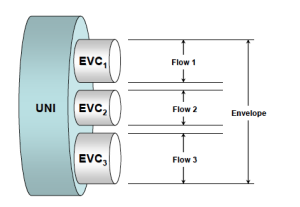Page History
Versions Compared
Key
- This line was added.
- This line was removed.
- Formatting was changed.
| Panel | ||
|---|---|---|
| ||
This page identifies the EVC per UNI service attributes enumerated in MEF 10.2 and MEF 10.3.
UNI EVC ID (Both MEF 10.2 and MEF 10.3) A string formed by the concatenation of the UNI ID and the EVC ID. Class of Service Identifier Service Attribute(MEF 10.3 only) Each frame that enters the CEN is assigned to exactly one class of service. This attribute specifies how that assignment is done. There are three (mutually exclusive) ways to determine the class of service for a Data Service Frame mapped to an EVC:
In addition, a class of service can be explicitly specified for Layer 2 Control Protocols that are passed to the EVC (i.e. tunneled), Color Identifier Service Attribute(MEF 10.3 only) This attribute specifies how to identify the "color" for each frame that crosses the UNI. A service frame need not have a color identifier, and if there is no color identifier then the frame is considered to be green. The following items can be used to identify the color of a frame:
Egress Equivalence Class Identifier(MEF 10.3 only) Each egress Service Frame mapped to the given EVC has a single Egress Equivalence Class Identifier. The Egress Equivalence Class Identifier can be determined from inspection of the content of the egress Service Frame. Each Egress Equivalence Class Identifier maps to a single Egress Equivalence Class. The Egress Equivalence Class is used to specify Egress Bandwidth Profiles. For a given EVC, the Egress Equivalence Class Identifier can be the CE-VLAN CoS or the IP DSCP field. Layer 2 Control Protocols (L2CPs) can be explicitly mapped to specific Egress Equivalance Classes. |
| Panel |
|---|
|
| Panel |
|---|
|
| Panel |
|---|
Bandwidth Profiles(Both MEF 10.2 and MEF 10.3) At the UNI, a service frame can be policed using a bandwidth profile. Bandwidth profiles (BWP) can be assigned at three levels, but each frame can only be policed by a single BWP. A BWP on the UNI, itself, will apply to all frames at the UNI and therefore can be the only BWP at the UNI. This is UNI Service Attribute and discussed here. If a BWP is not specified on the UNI then it can be specified individually for each EVC at the UNI. This BWP will meter all of the traffic on the EVC (see first diagram at right). Alternatively, any of the EVCs can have a BWP for each CoS carried on the EVC (see second diagram at right). If BWPs are assigned per CoS then there cannot also be a BWP on the EVC itself since the service frames would then have to traverse two BWPs. The following four attributes (two ingress and two egress) are used to specify these bandwidth profiles. These are EVC per UNI Service Attributes because the bandwidth policing values can be different at each UNI in each EVC.
|
| Panel |
|---|
 Image Removed
Image Removed
| Panel |
|---|
|
Source MAC Address Limit Service Attribute(MEF 10.3 only) Source MAC Address Limit can be ENABLED or DISABLED. If ENABLED, it can be configured with two parameters, a positive integer, N, which is the maximum number of MAC addresses that will be learned for the EVC at the UNI and t, the address aging value. If this attribute is ENABLED, and an ingress Service Frame arrives with a new source MAC address when the table already has N MAC addresses, the Service Frame is discarded. Test MEG Service Attribute(MEF 10.3 only) This attribute can be ENABLED or DISABLED. If ENABLED, the CEN must meet the mandatory requirements that apply to the TEST MEG specified in section 7.5 of MEF 30.1. Subscriber MEG MIP Service Attribute(MEF 10.3 only) This attribute can be ENABLED or DISABLED. If ENABLED, the CEN must instantiate a MIP at the Subscriber MEG Level as described in MEF 30.1. |
| Panel | ||
|---|---|---|
| ||
| Panel | ||||||
|---|---|---|---|---|---|---|
| ||||||
| Panel | ||||
|---|---|---|---|---|
| ||||
|
| Panel | ||||||
|---|---|---|---|---|---|---|
| ||||||
|
| Panel | ||
|---|---|---|
| ||
| Panel | ||||
|---|---|---|---|---|
| ||||
| Panel | ||
|---|---|---|
| ||
